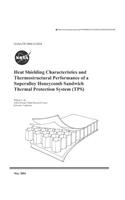
Heat Shielding Characteristics and Thermostructural Performance of a Superalloy Honeycomb Sandwich Thermal Protection System (Tps)
Series:
Heat-transfer, thermal bending, and mechanical buckling analyses have been performed on a superalloy "honeycomb" thermal protection system (TPS) for future hypersonic flight vehicles. The studies focus on the effect of honeycomb cell geometry on the TPS heat-shielding performance, honeycomb cell wall buckling characteristics, and the effect of boundary conditions on the TPS thermal bending behavio
NaN
VOLUME
English
Paperback

Heat-transfer, thermal bending, and mechanical buckling analyses have been performed on a superalloy "honeycomb" thermal protection system (TPS) for future hypersonic flight vehicles. The studies focus on the effect of honeycomb cell geometry on the TPS heat-shielding performance, honeycomb cell wall buckling characteristics, and the effect of boundary conditions on the TPS thermal bending behavior. The results of the study show that the heat-shielding performance of a TPS panel is very sensitive to change in honeycomb core depth, but insensitive to change in honeycomb cell cross-sectional shape. The thermal deformations and thermal stresses in the TPS panel are found to be very sensitive to the edge support conditions. Slight corrugation of the honeycomb cell walls can greatly increase their buckling strength.Ko, William L.Armstrong Flight Research CenterHEAT SHIELDING; THERMAL PROTECTION; THERMAL STRESSES; HONEYCOMB CORES; THERMAL BUCKLING; TEMPERATURE EFFECTS; SHAPES; PARTITIONS (STRUCTURES); HYPERSONIC VEHICLES
Price Comparison [India]
In This Series
Bestseller Manga
Trending NEWS




















